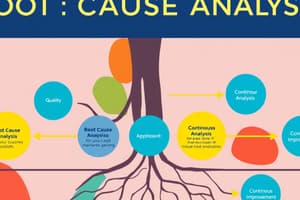Podcast
Questions and Answers
The Fishbone diagram is primarily used in the medical industry.
The Fishbone diagram is primarily used in the medical industry.
False (B)
Kaoru Ishikawa developed the Fishbone diagram in the 1940s.
Kaoru Ishikawa developed the Fishbone diagram in the 1940s.
False (B)
The Fishbone diagram is shaped like a circle.
The Fishbone diagram is shaped like a circle.
False (B)
The main categories of potential causes in the Fishbone diagram are always fixed and cannot be modified.
The main categories of potential causes in the Fishbone diagram are always fixed and cannot be modified.
The goal of the Fishbone diagram is to identify only the most obvious causes of a problem.
The goal of the Fishbone diagram is to identify only the most obvious causes of a problem.
The Fishbone diagram is used to analyze the effects of a problem rather than its causes.
The Fishbone diagram is used to analyze the effects of a problem rather than its causes.
The primary purpose of identifying possible causes of a problem is to allocate blame to specific teams or individuals.
The primary purpose of identifying possible causes of a problem is to allocate blame to specific teams or individuals.
The Fishbone diagram is a tool used exclusively for identifying root causes of problems.
The Fishbone diagram is a tool used exclusively for identifying root causes of problems.
Monitoring and reporting are optional elements in the SIRA process.
Monitoring and reporting are optional elements in the SIRA process.
Risk management measures are typically set in place for a fixed period and do not require review or adjustment.
Risk management measures are typically set in place for a fixed period and do not require review or adjustment.
Internal audits are a way to monitor the effectiveness of risk management measures.
Internal audits are a way to monitor the effectiveness of risk management measures.
Employees should only be involved in risk management processes if they are directly affected by the risks.
Employees should only be involved in risk management processes if they are directly affected by the risks.
The selection and application of tools and techniques in the SIRA process should be based on industry best practices rather than organizational needs.
The selection and application of tools and techniques in the SIRA process should be based on industry best practices rather than organizational needs.
Real-time monitoring and feedback mechanisms are not essential in a dynamic risk management process.
Real-time monitoring and feedback mechanisms are not essential in a dynamic risk management process.
Reporting on risks and controls should only be done internally and not shared with external stakeholders.
Reporting on risks and controls should only be done internally and not shared with external stakeholders.
The primary goal of risk management is to allocate blame rather than to improve processes and systems.
The primary goal of risk management is to allocate blame rather than to improve processes and systems.
Flashcards are hidden until you start studying
Study Notes
The Fishbone Diagram
- A visual tool used in Root Cause Analysis to systematically map and analyze possible causes of a specific problem or quality issue.
- Developed in the 1960s by Kaoru Ishikawa, a Japanese quality control specialist.
- Shaped like a fishbone, with a problem or issue described at the head, and "bones" representing main categories of potential causes.
Main Categories of Potential Causes
- Often grouped as People, Methods, Systems, and Environment, but can be modified based on the specific situation or industry.
- These categories help systematically consider different aspects of the problem and ensure a broad and inclusive analysis.
Identifying Possible Causes
- More specific causes or sub-causes are identified through brainstorming sessions with teams or analysis of data and processes.
- The goal is to go deeper into each aspect of the problem and identify all possible factors that may contribute to the problem.
Assessing and Prioritizing Causes
- Possible causes are assessed based on their likely impact and contribution to the problem.
- This helps prioritize which causes require further investigation and action.
Benefits of the Fishbone Diagram
- Provides a structured way to think about all possible causes of a problem and visualizes the relationships between these causes and the problem.
- Promotes team collaboration and participation, making it a powerful tool for collaborative problem analysis.
- Helps to look beyond the most obvious causes and encourages deeper analysis of underlying problems, leading to more sustainable and effective solutions.
Risk Management
- Identifying and addressing the most likely causes of problems can improve processes and systems, leading to better performance, higher quality products and services, and increased customer satisfaction.
- The selection and application of risk management tools and techniques should be tailored to the specific needs and context of the organization.
Monitoring and Reporting
- Crucial elements in the SIRA (Strategic Integrated Risk Assessment) and broader risk management process.
- Monitoring ensures the effectiveness of risk management strategies, controls, and procedures through regular reviews, Key Risk Indicators, and real-time feedback mechanisms.
- Reporting provides clear, accurate, and timely information about risks and the effectiveness of controls to stakeholders, supporting decision-making and dynamic risk management.
Studying That Suits You
Use AI to generate personalized quizzes and flashcards to suit your learning preferences.




